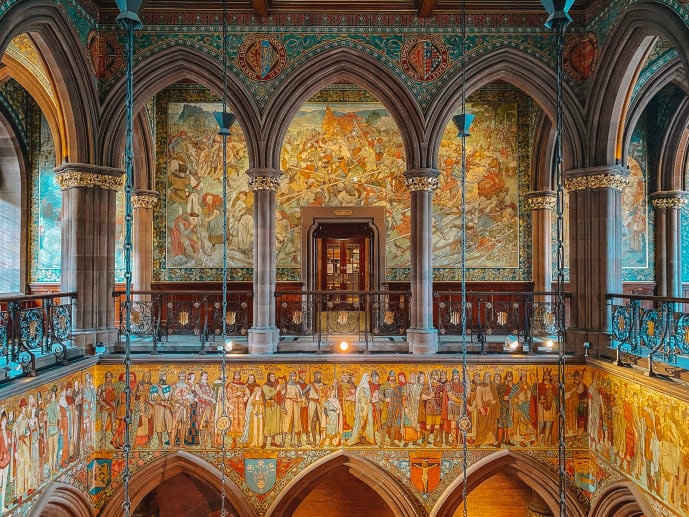The Scottish National Portrait Gallery: A Visual Chronicle of Scotland
Nestled in the heart of Edinburgh, the Scottish National Portrait Gallery stands as a monumental testament to Scotland’s rich history, culture, and artistic heritage. Housed in a striking neo-Gothic building, the gallery offers visitors an immersive journey through Scotland’s past and present, all captured through the medium of portraiture.
Origins and Historical Evolution
The inception of the Scottish National Portrait Gallery traces back to the late 18th century, with David Erskine, the 11th Earl of Buchan, playing a pivotal role. In 1780, Erskine founded the Society of Antiquaries of Scotland, which began collecting portraits of notable Scots. This collection laid the groundwork for what would become the national portrait collection. By the mid-19th century, the idea of establishing a dedicated portrait gallery gained traction, culminating in the opening of the Scottish National Portrait Gallery in 1889 .
Over the years, the gallery’s collection expanded, encompassing a diverse array of artworks, including paintings, sculptures, prints, and photographs. In 2011, a significant refurbishment, funded by the Scottish Government and the Heritage Lottery Fund, restored the gallery’s original layout and increased its exhibition space by 60%. This renovation enhanced accessibility and allowed for a more comprehensive display of the collection .
Architectural Grandeur
Designed by Sir Robert Rowand Anderson, the gallery’s building is a masterpiece of neo-Gothic architecture. Constructed from red sandstone sourced from Dumfriesshire, the structure features pointed arches, spires, and intricate carvings that evoke a sense of medieval grandeur. Notable sculptures of historical figures, such as William Wallace and Robert the Bruce, adorn the exterior, setting the tone for the historical journey within .
A Diverse and Expansive Collection
The gallery’s collection spans centuries, offering a window into the lives of individuals who have shaped Scotland’s identity. From monarchs like Mary, Queen of Scots, to cultural icons such as Billy Connolly and Tilda Swinton, the portraits provide insights into the nation’s evolution. The collection includes over 55,000 works, with a particular emphasis on historic photography and contemporary Scottish portraiture .
Highlights of the Collection
- Historic Portraits: The gallery houses iconic works like Henry Raeburn’s “The Skating Minister” and Allan Ramsay’s “Margaret Lindsay of Evelick,” which offer glimpses into 18th-century Scottish society.Financial Times
- Photography Collection: Pioneers such as David Octavius Hill and Robert Adamson are represented, showcasing the evolution of photography in Scotland .
- Contemporary Icons: Modern figures, including musicians, actors, and artists, are featured, reflecting Scotland’s dynamic cultural scene.
Educational and Cultural Impact
Beyond its role as an art institution, the Scottish National Portrait Gallery serves as an educational resource. The library and print room provide access to materials related to portraiture and Scottish history, supporting both academic research and public engagement . The gallery’s exhibitions often delve into themes of identity, power, and representation, prompting visitors to reflect on the narratives constructed through portraiture.
Notable Exhibitions
The gallery regularly hosts temporary exhibitions that explore various facets of Scottish history and culture. For instance, “The World of King James VI & I” examined the complex legacy of the Stuart monarchs, while “Imagining Power: The Visual Culture of the Jacobite Cause” explored the artistic representations of the Jacobite movement . These exhibitions enrich the understanding of Scotland’s past and its portrayal through art.
Visitor Experience
Located on Queen Street in Edinburgh, the Scottish National Portrait Gallery is easily accessible to both locals and tourists. Admission is free, making it an inclusive destination for art enthusiasts and history buffs alike. The gallery’s café and shop offer a welcoming environment for visitors to relax and reflect on their experience.
Conclusion
The Scottish National Portrait Gallery stands as a beacon of Scotland’s artistic and historical legacy. Through its diverse collection and thought-provoking exhibitions, it offers a comprehensive narrative of the individuals who have influenced the nation’s development. A visit to the gallery is not merely an encounter with art; it is a journey through the rich tapestry of Scotland’s past and present.

